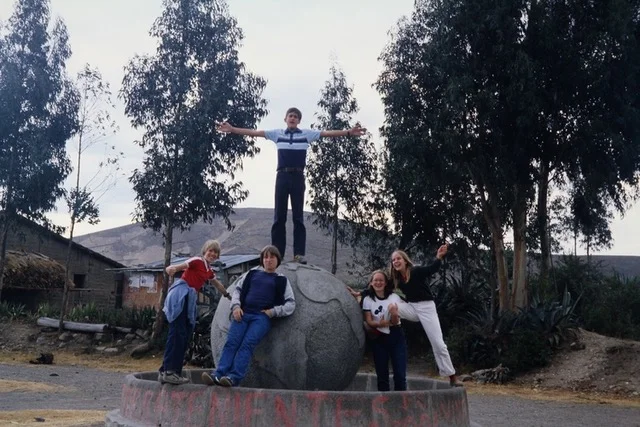Ecuador 1979
Ecuador was a side trip we took when we traveled to Peru in 1979. A good friend and classmate from when I attended the University of Miami, Alfredo Vasconez, lived in Quito, the capital city, and we thought it would be nice to visit him since Ecuador wasn’t very far from Peru. In 1979 there were few tourists visiting Ecuador, so we got to see the country in a more or less virginal state.
Ecuador is named after the equator, which runs through the country. Its official name is Republica del Ecuador, which translates to “The Republic of the Equator.” Not surprisingly, the biggest tourist attraction is the equator itself. There is a monument, aptly called “Middle of the World,” located twenty-six kilometers north of Quito, where you can stand with one foot in the northern hemisphere and the other in the southern.
Ecuador also has the distinction of having the world’s first and second UNESCO World Heritage Sites. At the inaugural UNESCO World Heritage conference in 1978, 32 sites were designated and numbered. Site #1 is the Galapagos Islands and #2 is the city of Quito.
Quito is situated high in the Andean foothills, at an altitude of 8,500 feet, making it the highest official capital city in the world. La Paz, Bolivia, is higher but it is not the constitutional capital, only the seat of government. The city is built on the foundations of an ancient Incan city, and is known for its well-preserved 16th and 17th century colonial buildings, including European, Moorish and indigenous architecture.
With our two sons, David and Mike, we flew from Lima to Quito. Alfredo met us at the airport and took us to his house where we met his family and spent an enjoyable two days and nights with them in their very comfortable house. They had two maids, one a live-in and the other who worked six days a week.
Dining with Alfredo’s family was a pleasure. The maids would cook the meal, serve it in courses, and do all clean up leaving us to devote our time to enjoying the meal and conversation. I was envious that they were able to have this help and suggested to Misti that perhaps we could do the same at our house in California, but she wasn’t interested in having full-time domestic help.
Alfredo was proud to show us his country and we spent one day touring both Quito and the surrounding countryside. I vividly remember visiting a small factory that made small bread figurines that they colored and then baked in an oven, for use as ornaments. I remember the powerful smell from the chemicals and noted that none of the young workers wore any masks.
Alfredo told us about a traditional Ecuadorian food, guinea pig, also known locally as cuy. Pronounced kew-y, in the indigenous language of Kichwa, because of the high-pitched bird-like sound the animal makes. Guinea pigs were the main source of meat before cattle were introduced to the country, and cuy became a status symbol because it meant you had enough money to eat meat. We tasted it and thought it was a bit like duck, rich and oily, but because we had trouble with the idea of eating a guinea pig, we chose not to eat much of it.
Because three years earlier, in 1976, we had driven our school bus converted to a camper on a three-month trip through Mexico and Guatemala, driving in foreign countries wasn’t something we feared. But Alfredo told us stories of a number of people in his family who had been killed driving highways in Ecuador, and this got our attention. Alfredo drove his car and a cousin drove another, and we toured for a day without having any close calls. But seeing the condition of the roads, and the very aggressive driving, we decided that renting a car in Ecuador wouldn’t be on our agenda.
We had read that Quito has one of the largest concentrations of ancient churches in all of Latin America and, with Alfredo as our guide, we set out visiting several which were clustered in the historic district. The most spectacular was the Basilica del Voto Nacional, an awe-inspiring cathedral which is the largest of all neo-Gothic cathedrals in the Western Hemisphere.
Huddling at the entrance were several older Indian women, begging for money. As I watched them, I had what I guess can be called an epiphany. I had always been a hard-core atheist, and still am, but when I saw those women I realized that religion has its place in the world. It your life seems worthless and painful, then perhaps it’s nice and even essential, that you can look forward to a better life after death. That realization changed my outlook on religious beliefs, at least for other people.
One of our trips with Alfredo was to the market in Otavalo, about a two-hour drive from Quito in Imbabura Province. The town is at a (literally) breathtaking altitude of almost 8,000 feet and is surrounded by several picturesque volcanoes rising to more than 16,000 feet. The Otavalo market is one of the largest in South America, and the indigenous Otavalo people are famous for weaving colorful textiles, usually made of wool, as well as all sorts of other handicrafts. At the time we visited, the market was relatively quiet, but a recent online search says it now attracts tourists from all over the world.
We only spent several days in Ecuador but in that time, with Alfredo’s help, we were able to see a great deal. We flew out of Quito headed home with a brief stop in Bogota, Columbia, bringing with us many great memories of our first trip to South America.
Art Faibisch
May, 2019



















































